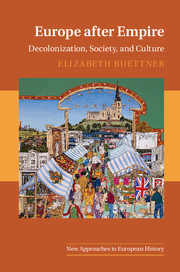Book contents
- Frontmatter
- Contents
- List of figures
- Acknowledgements
- Introduction
- Part I Decolonization for colonizers: Europe's transition to the postcolonial era
- Part II Migrations and multiculturalisms in postcolonial Europe
- Part III Memories, legacies, and further directions
- Epilogue: thoughts towards new histories of contemporary Europe
- Bibliography
- Index
Introduction
Published online by Cambridge University Press: 05 June 2016
- Frontmatter
- Contents
- List of figures
- Acknowledgements
- Introduction
- Part I Decolonization for colonizers: Europe's transition to the postcolonial era
- Part II Migrations and multiculturalisms in postcolonial Europe
- Part III Memories, legacies, and further directions
- Epilogue: thoughts towards new histories of contemporary Europe
- Bibliography
- Index
Summary
Every year in mid-November, the Netherlands begins its extended round of Christmas season festivities which, unlike in many countries, peak not on 25 December but on 5 December, or Sinterklaas – Saint Nicholas’ Eve. In cities and towns across the country and via broadcasts on national television, the Dutch equivalent of Santa Claus makes his arrival (intocht), coming not from the North Pole by sleigh but from Spain by boat. He is publicly welcomed by millions of spectators who typically brave inclement weather to watch him disembark from his steamboat, mount his white horse, and begin his procession through the streets. This national ritual captivates not only children and their parents but seemingly much of Dutch society, whose citizens treasure fond memories of the seasonal fun bookended by the local arrival ceremonies and the evening of the fifth, a family occasion when children receive presents from Sinterklaas. Even more beloved than Sinterklaas himself, an austere, almost larger-than-life elderly man dressed more like the Pope than the jolly Santa familiar in English-speaking countries, are the many helpers that make up his entourage: the clownishly boisterous group of men who collectively go by the name of ‘Zwarte Piet’, Black Piet. And every year, Zwarte Piet grows more controversial than before for the racist and colonial connotations he holds for a substantial minority of people in the Netherlands, once the heart of an overseas empire and now a postcolonial, multicultural society transformed by migration, much of it from former colonies.
Although commonly described as if its contours were age-old, like many European traditions Sinterklaas as celebrated today has only acquired its most recognizable aspects since the mid-nineteenth century, a time when the Netherlands had yet to abolish slavery in its colonies. While Zwarte Piet is officially proclaimed to be a Moor dressed in Renaissance attire, his role and appearance bring forth connotations of slavery and the blackface traditions once widely found in many Western societies scarred by racial inequality. Black Piet's die-hard defenders – of which there are millions – deny that he is black because he is or once was a slave from the West Indies, where the Netherlands ruled plantation colonies such as Dutch Guiana (now Suriname) and islands in the Antilles (West Indies) for centuries.
- Type
- Chapter
- Information
- Europe after EmpireDecolonization, Society, and Culture, pp. 1 - 20Publisher: Cambridge University PressPrint publication year: 2016

